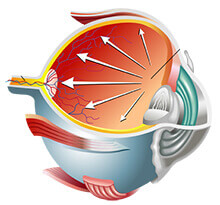
At Stahl Eyecare Experts, we have the latest instruments used to detect glaucoma and offer a variety of treatment options for our glaucoma patients. Our physicians will help decide which treatment (medicine, laser treatment or glaucoma surgery) is best for you. We are proud to offer the selective laser trabeculoplasty (SLT) procedure for qualified patients. This advanced laser therapy uses very low levels of safe laser energy to increase the outflow of fluid in patients with open angle glaucoma. The procedure is painless and takes minutes to perform. Because it is extremely effective, we are able to decrease the number of glaucoma medications and in some cases eliminate them entirely. Please ask our physicians if you are a candidate for this exciting technology.
The Silent Thief Of Sight
It is estimated that glaucoma is threatening the vision of two out of every hundred persons age 35 and over. Glaucoma can result in blindness and is one of the leading causes of blindness in the United States today. We refer to glaucoma as the “silent thief” because glaucoma typically has no symptoms until partial vision loss has occurred. Loss of vision due to glaucoma is irreversible.
Early diagnosis and treatment of glaucoma may prevent blindness and loss of vision. For this reason, it is important that persons over age 35 undergo an eye examination at least every 2 years, and persons with a family history of glaucoma may need more frequent examinations.
What is Glaucoma?
Glaucoma is defined as vision loss and optic nerve damage resulting from elevated eye pressure. The optic nerve is comprised of millions of nerve bundles which transmit light images to the brain where they are translated into what we know as sight. When the eye pressure is high, these nerve bundles are damaged and blind spots in areas of vision develop. With early glaucoma, these blind spots occur in the side (peripheral) vision and go undetected. Typically, there is no pain associated with the most common form of glaucoma. If the pressure inside the eye goes unchecked for a period of time, the damage increases and becomes permanent, and blindness results.
Glaucoma And Your Blood Pressure
Patients often ask: “If my blood pressure rises, will my eye pressure also rise?” The answer is no. The drainage of aqueous humor from the eye functions independently of the body’s vascular/circulatory system. Good control of blood pressure does not mean good glaucoma control.
The 4 types of Glaucoma
The aqueous humor is a clear, transparent liquid that continually circulates throughout the eye. When this circulation becomes restricted for one reason or another, pressure inside the eye begins to rise. Typically, there are four general types of glaucoma:
-
Chronic Open Angle Glaucoma
Chronic open angle glaucoma is by far the most common type. It occurs when the exit of aqueous humor from the eye is restricted by inadequate drainage. Chronic open angle glaucoma develops slowly over a long period of time and results in the quiet loss of vision, because no symptoms occur until the optic nerve is extensively and permanently damaged.
-
Angle Closure Glaucoma
Angle closure glaucoma occurs if the drainage system in front of the eye (the angle between the iris and cornea) is narrow or completely occluded, blocking the drainage of fluid. The eye pressure may rise suddenly (acute angle closure) or be chronically elevated (narrow angle glaucoma). In acute angle closure, patients develop the rapid onset of blurred vision, haloes around lights, severe pain, nausea and vomiting. Unless the pressure is brought under control rapidly, complete blindness may result in a very short time.
-
Congenital Glaucoma
If the outflow system of the eye exhibits abnormalities from the time of birth, congenital glaucoma may result. Infants born with glaucoma may be extremely sensitive to light and tear excessively, or the front of the eye may be enlarged or cloudy. Fortunately, this condition is uncommon. An eye examination is advised even for newborns if such symptoms are noted.
-
Secondary Glaucoma
Glaucoma may result from trauma or injury, diabetes, or previous stroke in the eye, or may happen as a result of certain medications or inflammation. These are all conditions which may lead to blockage of aqueous drainage from the eye and high intraocular pressures.
Detecting Glaucoma
The eye pressure is measured during your eye examination. We also examine the back of the eye to ensure the health of the optic nerve and to look for possible damage. Several other risk factors are a consideration in developing glaucoma, including a family history of glaucoma, ethnic origin, diabetes, anemia, or hardening of the arteries. It is important to understand that while treatment and surgery can usually prevent further vision loss, there is no way to restore vision already lost due to glaucoma.
Treating Glaucoma
Glaucoma can sometimes be controlled by topical medications (eye drops) or by oral medications. These medications assist the outflow of fluid or may decrease the amount of fluid produced within the eyes. All eye drops and oral medications have potential side effects.
If medications are not effective in the control of glaucoma, laser treatment may be indicated to decrease the eye pressure and preserve vision.








